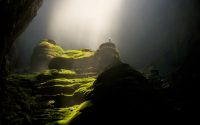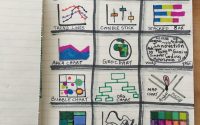Reflective Retrospective
This is an excerpt from the full paper written for eCampus Ontario. The full paper can be found as a PDF file, downloaded, and ready to review all the interactive links and diagrams.
As a culminating task for my work as an Ontario open education fellow (OEFellow), I’ve taken time to reflect on my open educational practices (OEPr) and how this past year has shifted my teaching and learning. I had to first frame this retrospective within the framework of my stated research plan.
” My OEFellow journey is shaped by two perspectives, that of learner and that of educator. These are interwoven. This retrospective completes my research commitment when I began this journey. My research plan was to examine how critical digital literacies, as defined by Hinrichsen and Coombs (2013), and negotiations into the open, as described by Cronin (2017), impact my work as an educator. As I look back, I’ll define and describe how this fellowship has shifted my professional work as an instructor in a Faculty of Education in Ontario.”
I’ve returned time and again to the notion of wayfinding, which has roots in design, user experience, movement, locality, and responsive iteration. Wayfinding became a consideration as I began writing my reflective retrospective. A metaphor I’ve used, from my Canadian context, is the image of an inuksuk, used as a marker left to show the way. This was also woven into this reflection.
” Wayfinding is a strategy commonly applied when travelling through physical spaces such as airports, hospitals, city centers, and new locations. For those who travel through such places, the signs and signifiers become evident in the navigational systems to be followed. There are markers that show the way. Looking back, you can spot them. This retrospective is not a complete wayfinding map, but my goal in writing this retrospective is to identify markers to show the way, so others who wish to travel can find a path into open educational spaces. While this story appears here as text, each hyperlink reveals my media rich story, captured in icons, images, graphics, audio, and video. It’s a modern day version of a traditional photo album travellers share after a journey is complete. Others may discover wayfinding strategies to mark their way into the open. In Canadian terms, this retrospective is my inuksuk, a legacy left on the open landscape.”
Defining open education – resources (OER), pedagogies (OEP) and practices (OEPr) – were not the primary focus for this reflection. There is more to be written in this area, but that will come another time. For this retrospective I shared graphic images I’ve created to help shape my thinking and shift my perspectives.
“My definition of open education has been refined and redefined throughout this OEFellows journey. I grappled with readings (Open Education), conversations (Open Stories), conceptions (Open Is …), and explorations (Open MOOC). My focus shifted from traditional open educational resources (OER), to open educational pedagogies (OEP). I’ve resolved to take a deeper dive into open educational practices (OEPr) [image of My OEPr]. My shifting definitions and understanding are surveyed in a blog post [Defining MY Open].”
Research is the starting point for my reflection, with work by Hinrichsen & Coombs (2013) and Cronin (2017) as foundational pieces. You can read more about how this research shaped my retrospective by accessing the full document [eCampus Ontario Open Education Fellows: A ‘Critical’ Retrospective]. As I summarized the research, I consider the impact of complexity in OEPr.
“This complexity is messy, fluid, iterating in action, and continually negotiated. I’m becoming accustomed to teaching and learning on the edge of my comfort zone. I’m attuned to the emergence of possibility in my own knowledge building, as I slide the dials up and into open spaces. I’m designing these OEPr spaces in order to push and support students as they begin to dial into the open as educators.”
I conclude with some thoughts about fellowship in the open.
“Fellowships continue on in memory. The OEFellows have left markers left on the landscape. This retrospective is my marker, not set in stone as seen on Canadian landscapes shaped as an inuksuk, but a pile of stones with which you can to build your own inuksuk. My hope is that you will find just the right elements in this collection of images, media, stories, and experiences so you can way-find and create as you travel into open educational spaces, here in our Ontario landscape, and beyond.”
“As I retrospectively review the work I do as an open educator, I’m reminded that being an OEFellow is about ‘fellowship’. I did not take this journey alone. There are others who have travelled alongside [Fellowship in the Open blog post]. We may not be on the same paths, or even in the same landscapes, but the markers we leave can reach beyond our individual spaces. Thanks is extended to my fellow OEFellows [Tweet by Bill of OEFellows]:
- Maureen Glynn @MGtheID
- Laura Killam @NurseKillam
- Dr. Aaron Langeville @aaron_lucs
- Jessica O’Reilly @JessicaOReill17
- Dr. James Skidmore @JamesMSkidmore
and those who supported the journey
- eCampus Ontario @eCampusOntario
- Ontario Extend @ontarioextend
- Jenni Hayman @jennihayman
- Peg French @livingkatstone
- Joanne Kehoe @joanne_kehoe
- Terry Greene @greeneterry
- Lena Patterson @lpatter10
- David Porter @davidp_eCO.
#OEFellows Amazing group and so lucky to know each of them! pic.twitter.com/JMWOrsUyhU— Bill J (@NeuroscienceUT) February 23, 2019

References
Cronin, C. (2017). Openness and praxis: Exploring the use of open educational practices in higher education. International Review of Research in Open and Distributed Learning, 18(5): 15-34. Retrieved from http://www.irrodl.org/index.php/irrodl/article/view/3096/4301
Hinrichsen, J. & Coombs, A. (2013). The five resources of critical digital literacy: a framework for curriculum integration. Research in Learning Technology 21:21334. doi: https://doi.org/10.3402/rlt.v21.21334

